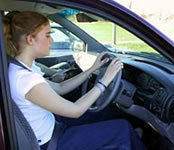 There
have been many calls recently for more to be done for the
safety of young drivers on the road. In most countries
around the world the situation is the same – young drivers
are involved in more crashes resulting in fatal and serious
injuries than would be expected given their numbers on
the road. The Australian Transport Safety Bureau reported
in 1996 that young drivers were involved in more than 30%
of fatal crashes even though they made up only 15% of the
driving population. There
have been many calls recently for more to be done for the
safety of young drivers on the road. In most countries
around the world the situation is the same – young drivers
are involved in more crashes resulting in fatal and serious
injuries than would be expected given their numbers on
the road. The Australian Transport Safety Bureau reported
in 1996 that young drivers were involved in more than 30%
of fatal crashes even though they made up only 15% of the
driving population.
This overrepresentation
has not changed much in the intervening years. In NSW
for example, crash data from the Roads and Traffic Authority
(2004) shows that drivers under 26 make up about 15%
of the drivers on the road, but are involved in 36% of
fatal and serious injury crashes. Young drivers have
more crashes at night than experienced drivers, and are
more likely to be involved in a crash if they carry two
or more passengers. And the situation is worse for the
boys – males make up almost
80% of the young drivers involved in fatal crashes.
Why are young drivers so overrepresented in crashes?
There are developmental reasons why young drivers have
difficulty with safe driving. The mid to late teenage years
are a time when young people are often developing their
own independence and becoming more self-confident. This
confidence can dip when they first start learning to drive
and find the coordination of skills and abilities to be
very difficult. However once they master the physical skills
of controlling a car, which doesn't take that long, they
can become overconfident very quickly. Combining this overconfidence
with a risk taking mentality can have disastrous consequences.
Young people have a strong
optimism bias – simply put,
they think they are bullet proof and can do anything. As
parents we would applaud this attitude in many areas of
life, but driving is not one of them.
Also, young people generally tend to externalise blame.
In the driving context this means they will often blame
other drivers or the road, or the weather for a crash or
a close shave. More experienced drivers are more likely
to take some or all of the blame on themselves.
Along with these developmental issues, young drivers also
lack the experience to be proficient at other perceptual
and judgment skills related to driving. Research has shown
that young drivers find it difficult to perceive hazards
and assess risks in the traffic environment. This is partly
because they tend to limit their scanning of the road environment
around the car. Young inexperienced drivers usually don't
look much further forward than the car in front of them,
and they often focus on objects which are not moving, rather
than moving objects like other cars. All this will affect
a young driver's ability to make quick, correct decisions
when faced with risk situations on the road.
What can parents do?
Many parents have to take on the role of supervising their
teenagers as learner drivers. Here are some general tips
which might help parents survive this stressful period
and develop a safer, low risk driver:
-
Provide your learner with as much driving
experience as possible. It's hard to say how much is
enough, but most research in this area suggests at
least 100 hours.
-
Build variety into
the practice. Drive in varying traffic, weather and
road conditions according to the ability of your
learner, moving from easier to harder conditions
over time. Don't avoid rainy days or driving at night – they
need this experience.
-
Before you have
a lesson, discuss the route of the drive and what
particular skills you will work on. Talk about things
which may be issues such as whether the music will
be on or if there will be passengers in the car.
-
During your lesson,
try to avoid talking, guiding and directing all the
time. Allow some quiet time for your learner to fully
concentrate and take responsibility for themselves.
Although you'll need to say something in any risky
situations, it is best to discuss problems and poor
decisions at the end of the lesson rather than during
it.
-
Remember that learning
to drive is hard and complex, and that learning anything
requires some trial and error. Encourage your learner
by praising them when they do things well, and discuss
problems and shortcomings in terms of what you will
both try and do next time.
Also, whether you like it or not, your children observe
your behaviour as a driver and will often copy that behaviour.
So practice what you preach and drive safely! Observe speed
limits and don't take risks. It's also useful to commentate
what you are doing when you are driving and your teenager
is a passenger. This demonstrates what you are looking
at and where you perceive hazards, and will help your learner
when it comes to their turn.
And finally, practise, practise, practise!
References
Australian Transport Safety Bureau (1996) Young Driver
Research Program: Digest of Reports and Principal Findings
of the Research. CR 164
NSW Roads and Traffic Authority (2004) Improving Safety
for Young Drivers. RTA Pub.04/315
Web links
For further information on young driver safety the following
web sites may be useful:
www.youthsafe.org
www.atsb.gov.au
http://www.mynrma.com.au/member_centre.asp
www.rta.nsw.gov.au
 |

